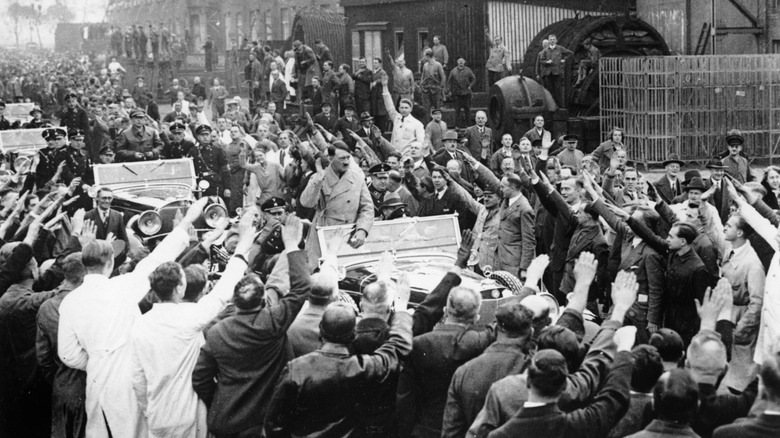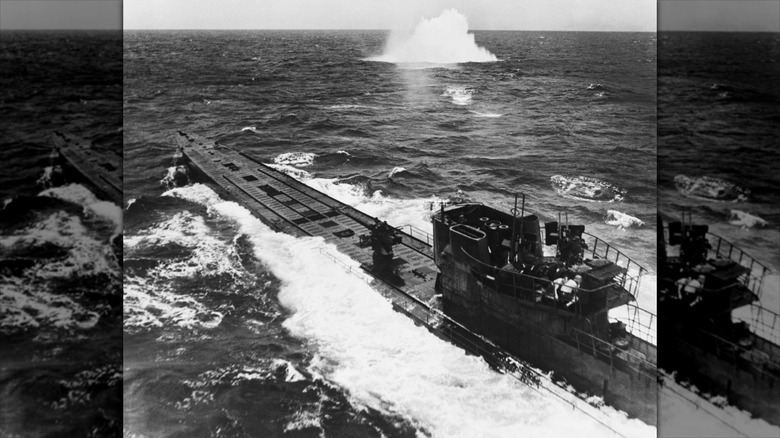The Bizarre Way The Phrase 'Heil Hitler' Saved Millions Of Lives In WWII
When Adolf Hitler's National Socialists (or Nazis) came to power in Germany in January 1933, he and his sympathizers quickly went about changing the country's society to reflect their party's fascism. Much of this came through a crackdown on aspects of culture they found "degenerate" (like modern art) and the promotion of aesthetic values that harkened back to the Roman Empire. Their seemingly imperial aspirations were transmitted by the use of distinctive salutes, as well as their own version of the Roman "Hail Caesar": "Heil Hitler." The image was complemented with displays of great military strength that struck terror into the nations of Europe and the millions of innocent people who were terrorized by the Nazis in the 1930s and 1940s.
While imperial posturing no doubt helped the Nazis convince the rest of the world of their power, their use of the phrase "Heil Hitler" ultimately came back to bite them. It was uttered by everyone from children in school to everyday Germans as they went about their daily lives. Yet it was its use throughout the military and in the Nazi upper command that gave the Allies a huge advantage in their quest to crack the Enigma machine. This system of message encryption prevented the enemies of Nazi Germany from intercepting classified communications and learning valuable military secrets. Experts now say that deciphering the Enigma code brought World War II to an end two years earlier than it would otherwise, saving millions of lives.
The importance of cracking the Enigma code
Soldiers and weapons are the first things that spring to mind with the mention of war. But the truth is both intelligence and communication are also vital to any military action, especially when they're occurring on a large scale, as was seen during World War II. And nowhere was this more clear than during the Battle of the Atlantic, the brutal naval conflict that began in 1939 and lasted until World War II finally ended in Europe on May 8, 1945.
Before the United States entered World War II in 1941, the Axis powers had largely conquered Europe and driven the remaining forces of Great Britain out of France. With British forces having escaped capture via the daring evacuation at Dunkirk in spring 1940, the nation found itself isolated, with the Nazis planning an invasion of the United Kingdom as its next step toward dominating the continent. The Battle of the Atlantic saw German U-Boats intercept British trade routes and destroy cargo ships coming from Canada and the United States, which the Nazis believed would eventually force the U.K. to surrender. Cracking the Enigma code would mean the Allies could gain vital intelligence on the planned U-Boat attacks against Allied shipping and allow the U.K. to continue its resistance.
Flaws in Nazi communications
It's impossible to overstate the sophistication of the Nazis' famous Enigma machine for the era in which it was used. The device was developed by German engineer Arthur Scherbius, and it looked like a clunky typewriter. Users simply typed in a message, which would then be encrypted with the use of interchangeable rotors, which together with a plug board on the front of the device meant that there were 103 sextillion possible encryptions per message.
Buoyed by the information that Polish mathematicians had managed to crack an earlier version of the Enigma code as early as 1932, the British set up the Enigma Research Section at Bletchley Park, where a team of codebreakers worked on systems to decode the Nazi messages. Central to their work was the assumption that the phrase "Heil Hitler" would likely appear somewhere in each message, which would also contain other recurring details, such as references to the weather.
The breakthrough came in the form of the Bombe, a manual device invented by Bletchley Park codebreaker Alan Turing. It featured many drums that replicated the rotors of the Enigma machine and was able to quickly test different encryption settings. A team of women operators known as Wrens would work around the clock to decode the daily Enigma code, scanning for phrases such as "Heil Hitler." Upon cracking it, they passed on the information to British intelligence and the wider Allied forces.


